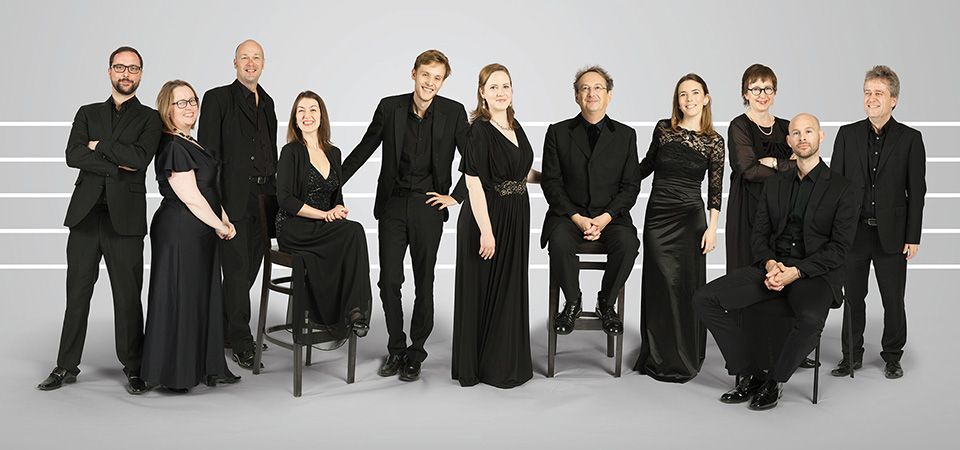
THE METHUSELAH OF MAESTROS
BERKELEY, CA—Peter Phillips has been conductor of Britain’s Tallis Scholars chamber chorus so long, some of his 10 singers were not even born when he started. Amazingly, over these 47 years the Scholars have maintained their amazing prowess at renaissance music in concert and recordings as they returned to the First Congregational Church for the 19th time. Needless to say, the performance was sold out with modern-day enthusiasts thronging for olden-day church music.
Is anything ever new in renaissance music? Well, yes. This round focused on the 16th-century composer Palestrina, who has been credited with saving Western music. In that era, unaccompanied polyphonic singing in church had become more and more complex in opuses written by Victoria, Josquin, di Lasso and hundreds of others, with their words virtually unintelligible.
That ultra-ornate style done on sacred texts, sometimes quoting popular tunes buried in the bass clef, was deemed sinful and sacrilegious. (Please, I’m not making this up!) Just when a church ban on all polyphonic music was brewing in the 1562 Council of Trent, Palestrina mollified the abolitionists with his “Missa Papae Marcelli” (Mass of Pope Marcellus). This was a streamlined music moving toward homophony and homorhythm, with words more clearly fleshed out. It found such support in the Vatican that no ban was ever issued. And Western music was “saved.”
More than a century later, another ban was lifted via the brash intervention of a genius 14-year-old named Mozart. At that time, the unaccompanied chorus “Miserere” by Gregorio Allegri could be heard and played only at the Vatican’s St. Peter’s Basilica, with excommunication assured for any one violating the stricture. Never underestimate the precocious Wolfgang Amadeus. He heard it twice there and came up with a very accurate score, fully written out, that was published in far-off London the next year.
With the cover blown, Mozart was automatically excommunicated (and conceivably in the process, all of us subsequent devotees of Mozart’s music) but for one follow-up detail. The Pope Urban VIII was so impressed by the budding musical genius that he showered the youngster with praise and immediately lifted the ban. We can all breathe sighs of relief.
The Allegri “Miserere” is far from elementary. It follows Palestrina’s renewal path in essence, using the Latin text of Psalm 51 and adding the complexity of antiphonal elements and broadened spectrum, with sopranos soaring up to high C’s. Done in several stanzas, it is absolutely gorgeous, enough to set shivers of delight down one’s spine. Running 12 minutes, the Scholars’ interpretation involved a subset of angelic sopranos with high C near the entrance, the body of the singers on stage, and one tenor doing chants off to the side. Here was spatial music as, perhaps, no one had encountered before Allegri, who composed this nearly 400 years ago. And here too was a stunning manifestation of the “underage” Mozart, his musical gift and his astounding memory bank.
The Scholars carried it off exultantly, with the sopranos at the forefront. In this program of 16th-century church music, Phillips set a leisurely pace, with most (metronome) tempos in the 50-55 range, using no baton, just hands in comfortable “stroking the cat” motions. Of several Palestrina selections, including a Credo from the trail-blazing “Missa Papae Marcelli,” clarity of the diction was decidedly improved over featured forerunning composers (like Josquin and Morales).
Should these choruses be performed in the concert hall exactly as when featured within a church service? Yes and no. Purists and traditionalists would say yes. But in a cathedral with resonant acoustics, and the faithful praying and meditating, a slow pace that some might term dragging would seem better. In a concert hall, a more animated pace would be preferable, at least for these ears. (The scores usually provided no written tempo clues.)
One advantage of the concert hall: many a time I heard these works in High Mass at European churches, where the first line only is intoned by the earnest but elderly pastor/celebrant in a struggling voice and struggling pitch.
On the other hand, the Scholars’ tenor doing these opening lines (called incipit), as heard April 4, was stirring and in pitch! In pitch like his colleagues, consisting of five women and five men in all.
Tallis Scholars singing works of Palestrina, Allegri, Festa, Carpentras, Josquin, Morales, Campkin April 4, First Congregational Church, Berkeley, under Cal Performances (CP) auspices. For CP info: (510) 642-9988, or go online.